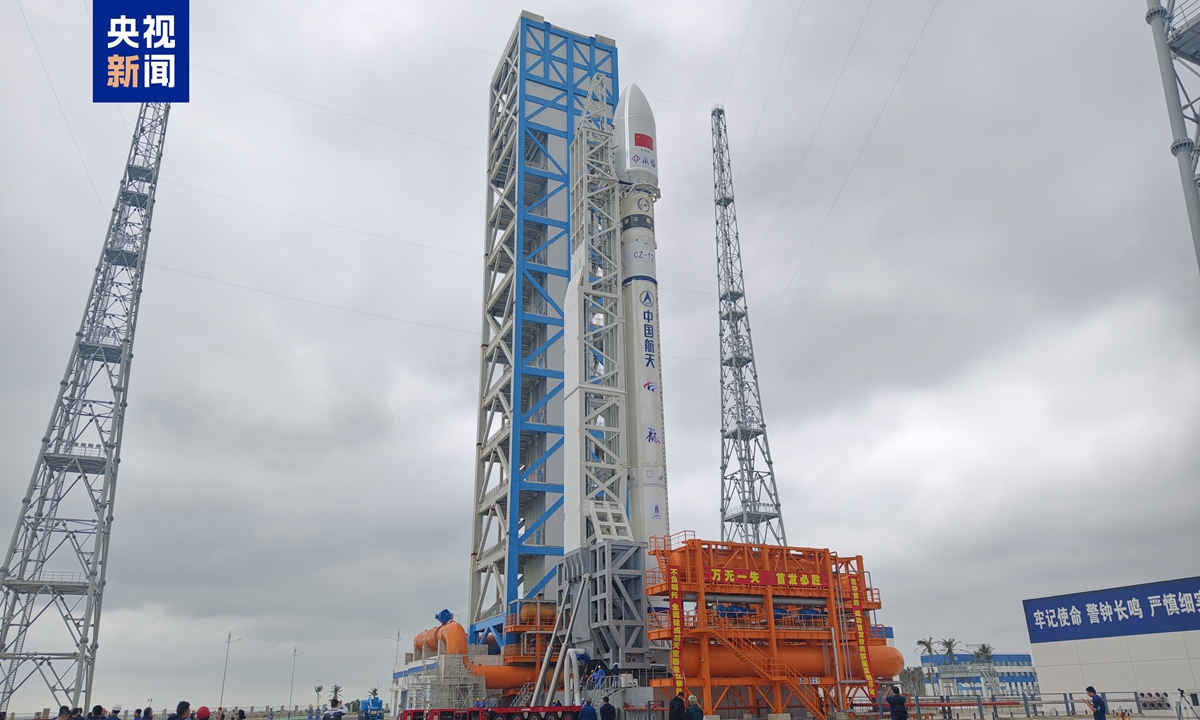New rocket in China’s Long March series to make maiden flight, laying foundation for reusability

China's Long March-12 Y1 carrier rocket sits at the launch area at the Hainan Commercial Space Launch Site in South China's Hainan Province on November 26, 2024. (Photo/CCTV)
After being transported to a launch pad at the Hainan Commercial Space Launch Site on Tuesday, a new member of China's Long March carrier rocket family, the Long March-12, has been scheduled to undertake its maiden flight in the next few days.
Experts said due to its enhanced overall capacity, the new rocket, which is the country's first single-core liquid carrier rocket with a diameter of 3.8 meters, will gradually replace China's older 3.35-meter diameter series. With better reliability in attitude control, the Long March-12 is expected to become the basic model for future reusable rockets in China.
The rocket, developed by the Shanghai Academy of Spaceflight Technology, features a two-stage configuration. The first stage is powered by four liquid oxygen/kerosene engines, each with a thrust of 1,250 kilonewtons, while the second stage uses two liquid oxygen/kerosene engines with a thrust of 180 kilonewtons each, China Central Television reported.
Its payload capacity to low Earth orbit is no less than 10 tons, and its capacity to reach a 700-kilometer sun-synchronous orbit is no less than 6 tons. The rocket's fairing is standardly available in diameters of 5.2 meters and 4.2 meters, allowing for multi-size adaptation based on different missions, the report said.
Apart from the 5-meter diameter Long March-5 rocket, the "fatty" in the family, the Long March series typically features a diameter of 3.35 meters, while solid rockets are generally slimmer, with diameters usually below 3 meters.
The Long March-12 rocket represents a significant advancement in the country's space launch capabilities, as the increased diameter addresses the limitations of the previous 3.35-meter rockets, allowing for more powerful engines, enhanced payload capacity, and better expandability of rocket thrust. Therefore, the Long March-12 is expected to significantly improve overall launch capability compared to previous generations, gradually replacing the older 3.35-meter models, Chinese space analyst Song Zhongping told the Global Times on Tuesday.
According to CCTV, the pioneering shape of the Long March-12 is based on the improved development of China's new generation of main liquid oxygen/kerosene engines, the YF-100 series, and is the result of repeated verification, research, and testing.
This notable feature allows for both railway transportation to various launch sites and the optimization of compatibility between the rocket's diameter and the number of engines, facilitating capability expansion and thus laying the groundwork for future reusable rockets, experts said.
Song pointed to an important technical parameter for launch vehicles, the length-to-diameter ratio, which affects the rocket's stability during recovery.
"Theoretically, a more optimal length-to-diameter ratio enhances the stability of a reusable rocket. The previous 3.35-meter rocket was relatively slender and long, making it more challenging to control its attitude. By increasing the diameter, the length-to-diameter ratio can be reduced, making it easier to control the rocket's stability and facilitating recovery," he said.
The expert anticipates that the Long March-12 rocket will become the basic model for future reusable rockets in China, while allowing for the development of various configurations based on it. This standardization will be crucial for the future of rocket recovery and reuse, Song noted.
Previous media reports said the Hainan Commercial Space Launch Site will be equipped with two liquid rocket launch pads. The first launch pad will be dedicated to the Long March-8 carrier rocket, while the other launch pad will provide launch services for the Long March-12 vehicle.
Photos
Related Stories
Copyright © 2024 People's Daily Online. All Rights Reserved.









